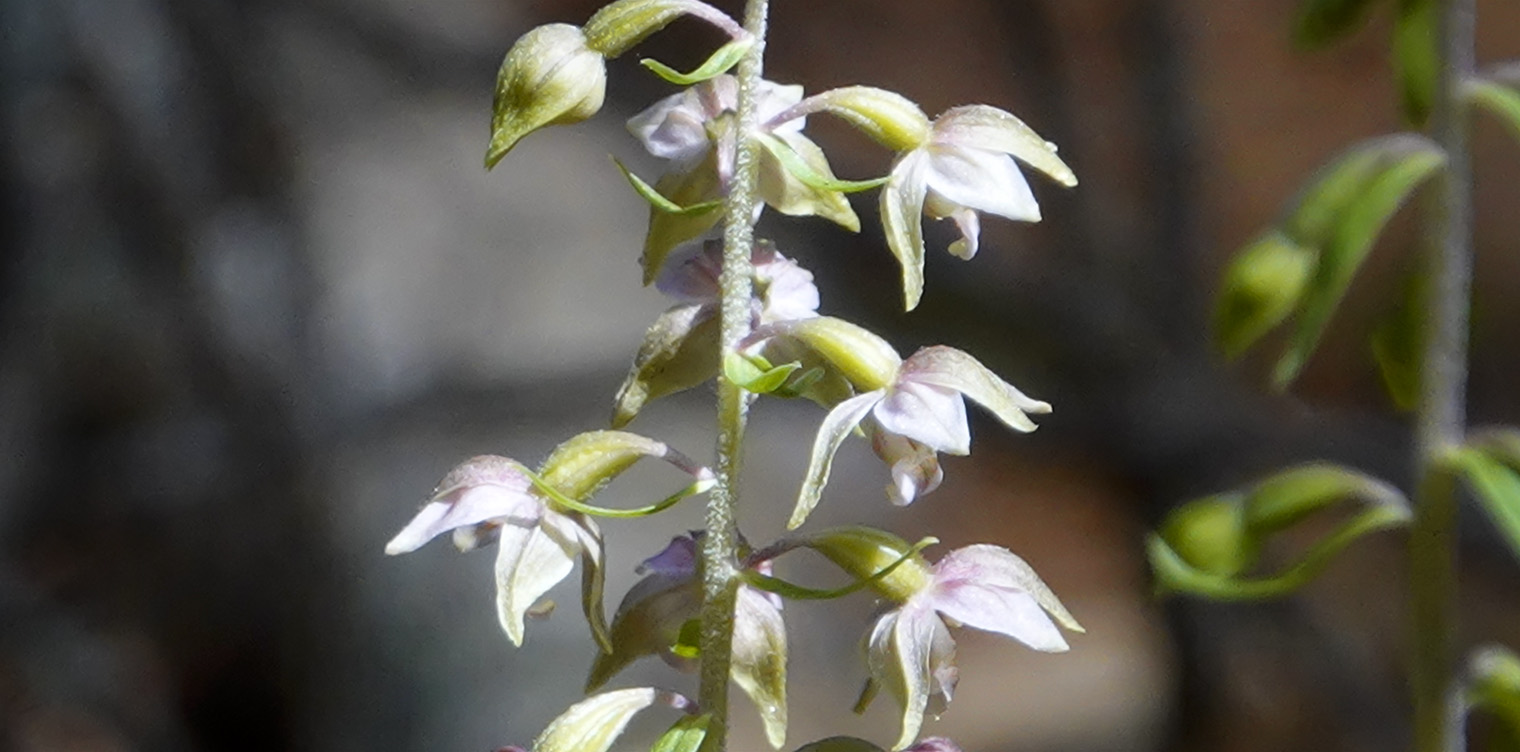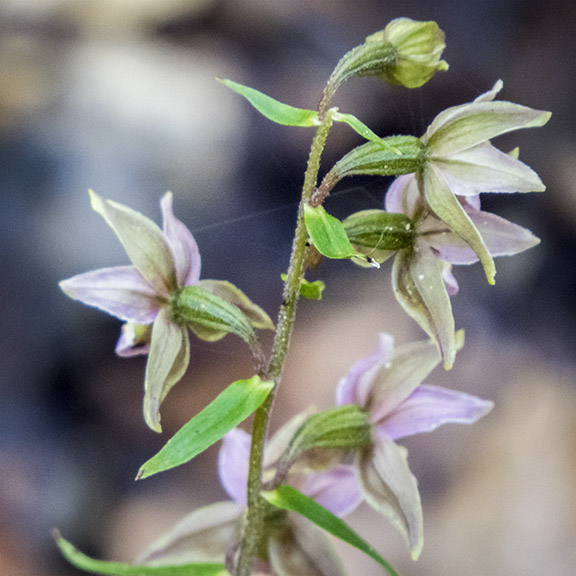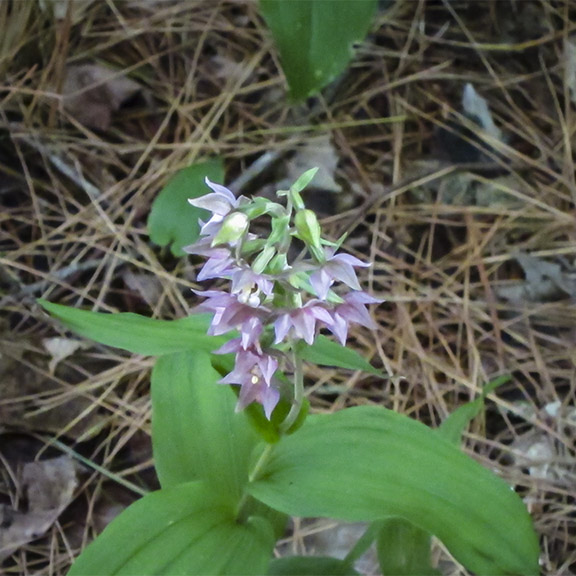Wildflowers of the Adirondacks:
Helleborine (Epipactis helleborine)

Helleborine (Epipactis helleborine) is a non-native orchid which produces small purplish green flowers in the summer. It grows in shaded woodlands throughout the Adirondacks.

Helleborine is a member of the Orchid family. It is also known as Broadleaf Helleborine, Eastern Helleborine, Weed Orchid, Broad-leaved Helleborine, and Helleborine Orchid. According to one source, this genus which was originally called hellebore, which apparently refers to a milk-curdling property claimed for some species.
Helleborine is the only alien orchid found in New York State. It is an escaped orchid of Eurasian origin. This plant was first reported near Syracuse, New York, in 1879. It has since spread throughout much of the northeast, as well as north to southern Ontario, west to Minnesota and south through Pennsylvania. It has become the most common woodland orchid in its range.
Helleborine is not considered to pose an environmental problem in most areas and is not included in most invasive plant lists for the US, New York State, or the Adirondack Mountains. However, it is viewed as an invasive species in Wisconsin, where it has become a serious problem in Door County.
Identification of Helleborine

Helleborine plants grow one to three feet in height. The stem is light green and covered with short hairs.
The leaves are oval to lance-link and alternate. They are 1.5 to 6 inches long, and 1.2 to 3 inches wide. The leaves clasp the stem. The veins in the leaves are parallel. The edges of the leaves are slightly wavy. The leaves are variable in size, with the leaves becoming smaller as they ascend the stem.
Helleborine's small greenish-purple flowers are arranged in a spike-like cluster of up to fifty stalked flowers on the top of the stem. The flowers are 1/2 to 3/4 inches wide. The lower petal forms a bowl, with a greenish-purple lip. The sepals are light green with purple veins. The color of the petals is somewhat variable, ranging from pale yellow green to pink to deep reddish purple, usually with darker purple veins. In the Adirondacks, Helleborine usually flowers in late July and August.
Uses of Helleborine
No medicinal or edible uses of Helleborine were found.
Wildlife Value of Helleborine
No wildlife uses of Helleborine were found.
Distribution of Helleborine
The plant can be found throughout the Northeastern United States, south to Tennessee. It can also be found along the western seaboard, including California and British Columbia. Helleborine is found in nearly all counties in New York State. Its presence has been confirmed in all counties within the Adirondack Park Blue Line, with the exception of Washington County.
Habitat of Helleborine
Helleborine grows in mesic forests, along roadsides, and on disturbed sites. It prefers well-drained sites, often under hardwoods. Helleborine is found along many of the trails covered here.
References
Michael Kudish. Adirondack Upland Flora: An Ecological Perspective (The Chauncy Press, 1992), pp. 234-235.
New York Flora Association. New York Flora Atlas. Helleborine. Epipactis helleborine (L.) Crantz. Retrieved 14 April 2017.
United States Department of Agriculture. The Plants Database. Broadleaf Helleborine. Epipactis helleborine (L.) Crantz. Retrieved 14 April 2017.
Flora of North America. Epipactis helleborine (Linnaeus) Crantz. Retrieved 14 April 2017.
NatureServe Explorer. Online Encyclopedia of Life. Epipactis helleborine - (L.) Crantz. Retrieved 14 April 2017.
Connecticut Botanical Society. Helleborine. Retrieved 14 April 2017.
University of Wisconsin. Flora of Wisconsin. Epipactis helleborine (L.) Crantz. Retrieved 14 April 2017.
Minnesota Wildflowers. Epipactis helleborine (Helleborine). Retrieved 14 April 2017.
Lawrence Newcomb. Newcomb's Wildflower Guide (Little Brown and Company, 1977), pp.48-49.
Roger Tory Peterson and Margaret McKenny. A Field Guide to Wildflowers. Northeastern and North-central North America (Houghton Mifflin Company, 1968), pp. 371-373.
William K. Chapman, et al. Wildflowers of New York in Color (Syracuse University Press, 1998), pp. 114-115.
Steven Clemants and Carol Gracie. Wildflowers in the Field and Forest: A Field Guide to the Northeastern United States (Oxford University Press, 2006), pp.132-133.
Information on Non-native Plants
United States Department of Agriculture. List of Federal Noxious Weeds. Retrieved 14 April 2017.
United States Department of Agriculture. Composite List of Federal and State Noxious Weeds. Retrieved 14 April 2017.
Invasive Plant Atlas of the United States. Retrieved 14 April 2017.
National Invasive Species Information Center. Species Profiles. Retrieved 14 April 2017.
New York Invasive Species Clearinghouse. Invasiveness Assessment Scores and Ranks for 183 Nonnative Plant Species in NYS. Retrieved 14 April 2017.
Adirondack Park Invasive Plant Program. Terrestrial Invasive Plant Project. Retrieved 14 April 2017.
